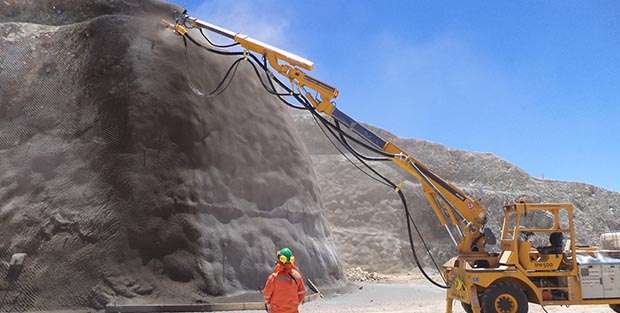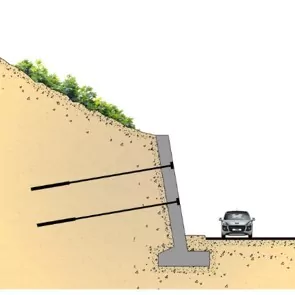Introduction
As urban development and infrastructure projects expand into areas with challenging terrain, the need for effective slope stabilization and erosion control becomes increasingly critical. Slope instability caused by natural forces, such as rainfall, wind erosion, or seismic activity, can lead to safety hazards, environmental damage, and infrastructure failure. Shotcrete, a versatile and cost-effective construction material, has emerged as a preferred solution for mitigating these issues.
Shotcrete refers to the method of applying concrete or mortar pneumatically onto surfaces through a high-pressure hose. The process ensures strong adhesion to irregular surfaces, making it ideal for slope protection and erosion control applications. This article explores the benefits, techniques, and applications of shotcrete in addressing these engineering challenges.
Benefits of Shotcrete for Slope Protection and Erosion Control
1.Flexibility in Application: Shotcrete can be applied to various surface geometries, including steep and irregular slopes, making it suitable for complex terrains.
2.Rapid Installation: Compared to conventional methods, shotcrete can be installed quickly, reducing project timelines and costs.
3.High Strength and Durability: Shotcrete offers high compressive and tensile strength, ensuring long-lasting protection against erosion, water infiltration, and soil movement.
4.Cost-Effectiveness: With minimal formwork requirements and reduced labor needs, shotcrete is a cost-efficient solution for slope stabilization projects.
5.Environmental Adaptability: The material can be applied without significant disturbance to surrounding ecosystems, preserving natural features while enhancing slope stability.
Techniques of Shotcrete Application
Shotcrete can be applied using two main techniques:
1.Dry-Mix Shotcrete: In this method, pre-blended dry materials (cement, sand, and additives) are fed into a hose, where they are mixed with water at the nozzle before being projected onto the slope. Dry-mix shotcrete offers better control over water content, making it suitable for smaller-scale projects and repairs.
2.Wet-Mix Shotcrete: In wet-mix shotcrete, the concrete mix (including water) is prepared beforehand and pumped through the hose to the nozzle, where compressed air propels the material onto the surface. Wet-mix shotcrete is often preferred for large-scale projects due to its higher output and reduced dust emissions.
Both methods can be reinforced with steel mesh, fibers, or soil nails to enhance structural integrity and resistance to external forces.
Key Applications of Shotcrete in Slope Protection
1.Slope Stabilization: Shotcrete is widely used to stabilize slopes susceptible to landslides, rockfall, and soil erosion. By creating a reinforced concrete shell, it prevents soil movement and surface degradation.
Example: Shotcrete applied to steep road embankments to secure unstable slopes and prevent rockfall onto highways.
2.Erosion Control: In areas prone to surface erosion from water runoff or wind, shotcrete provides a durable protective layer that minimizes soil loss and surface damage.
Example: Shotcrete used to reinforce riverbanks, canals, and drainage channels to control erosion caused by water flow.
3.Retaining Structures: Shotcrete can be integrated with retaining walls or soil nailing systems to support vertical or near-vertical slopes, offering stability to cut slopes in construction zones.
Example: Stabilization of excavation sites with shotcrete and soil nails during urban construction projects.
4.Rockfall Protection: In mountainous or rocky terrains, shotcrete creates a bonded protective layer over loose rock formations, mitigating the risk of rockfalls and debris slides.
Example: Shotcrete applied to cliff faces near transportation routes to prevent rockfall hazards.
5.Environmental Rehabilitation: Shotcrete is often combined with revegetation techniques to rehabilitate degraded slopes. The addition of seeds and fertilizers within the shotcrete mix promotes vegetation growth, further improving slope stability and aesthetics.
Example: Shotcrete embedded with biodegradable erosion control mats to encourage plant growth on slopes.
Considerations for Shotcrete Application
To ensure the success of shotcrete in slope protection, the following factors must be considered:
1.Site Assessment: Conducting geotechnical studies to determine slope conditions, soil composition, and water drainage patterns.
2.Material Selection: Choosing the appropriate shotcrete mix design, including cement type, additives, and reinforcement, to meet project requirements.
3.Application Technique: Selecting the suitable method (dry-mix or wet-mix) based on project scale, accessibility, and environmental considerations.
4.Quality Control: Implementing strict quality control measures during mixing, application, and curing to ensure shotcrete performance and longevity.
5.Environmental Impact: Minimizing disruption to natural habitats and incorporating sustainable practices, such as revegetation.
Conclusion
Shotcrete has proven to be an invaluable tool for slope protection and erosion control, offering strength, versatility, and cost efficiency in addressing slope stabilization challenges. Its ability to conform to irregular surfaces and provide durable, long-term solutions makes it a preferred choice in civil engineering and infrastructure projects. By combining innovative techniques with environmental considerations, shotcrete not only safeguards infrastructure but also promotes sustainable land management practices.
From stabilizing steep embankments to protecting riverbanks against erosion, shotcrete applications continue to play a crucial role in ensuring the safety, functionality, and resilience of both natural and built environments.







